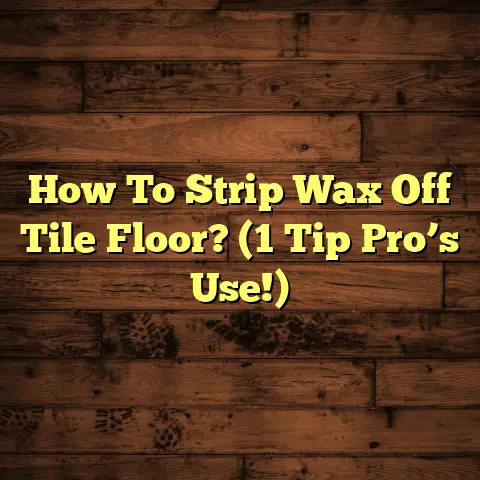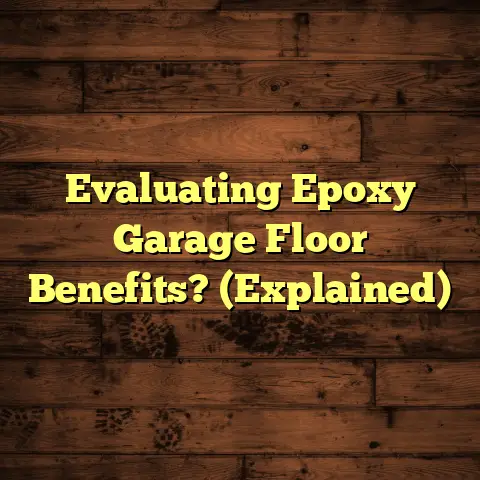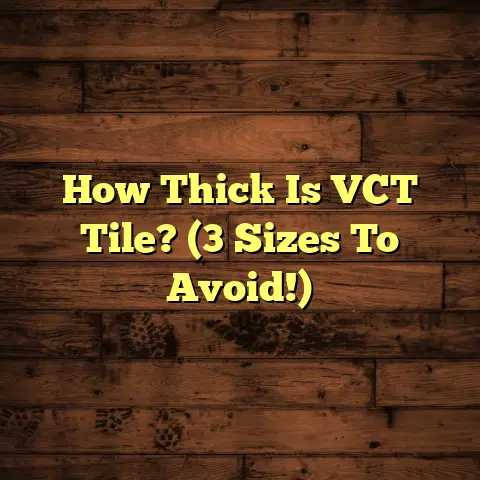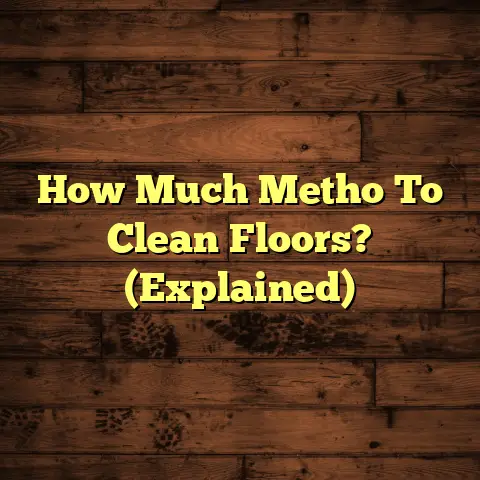Fake Hardwood Floor Cost? (4 Hidden Expenses!)
Investing in your home is always a smart move, right? Whether it’s a fresh coat of paint, a kitchen remodel, or new flooring, these upgrades not only make your living space more enjoyable but can also increase your home’s value.
Flooring, in particular, is a big one. And lately, I’ve noticed a huge surge in the popularity of “fake” hardwood floors – you know, laminate and engineered wood.
They’re often pitched as an aesthetic upgrade that won’t break the bank, a cost-effective alternative to the real deal.
But here’s the thing: while the initial price tag might look tempting, there are hidden expenses that can really add up and throw a wrench in your budget.
Think of flooring not just as a purchase, but as a long-term investment in your home’s value and livability. It’s about creating a space you love and increasing your home’s appeal should you ever decide to sell.
So, before you jump on the fake hardwood bandwagon, let’s dig into those hidden costs and make sure you’re making a truly informed decision. Ready? Let’s go!
Understanding Fake Hardwood Floors
Okay, so what exactly are we talking about when we say “fake” hardwood floors? Well, it’s an umbrella term for flooring options that mimic the look of real wood but are made from different materials.
The two main types you’ll come across are laminate flooring and engineered hardwood.
Laminate Flooring:
Think of laminate as a high-resolution photograph of wood, glued onto a composite core. Seriously! It’s made up of several layers:
- Wear Layer: A transparent top layer that protects against scratches, stains, and fading.
- Decorative Layer: This is where the magic happens. A high-definition image of wood grain is printed onto this layer, giving the flooring its realistic appearance.
- Core Board: The thickest layer, usually made of high-density fiberboard (HDF) or medium-density fiberboard (MDF). This provides stability and impact resistance.
- Backing Layer: A bottom layer that provides stability and helps prevent moisture from seeping into the core.
Engineered Hardwood:
Engineered hardwood is a bit closer to the real deal. It features a thin layer of actual hardwood veneer glued to a core of plywood or HDF. This construction makes it more stable than solid hardwood, meaning it’s less prone to warping or expanding and contracting with changes in humidity.
Benefits of Fake Hardwood Floors:
- Ease of Installation: Many fake hardwood floors are designed with click-lock systems, making them relatively easy to install yourself.
- Durability: The wear layer on laminate flooring is incredibly tough, making it resistant to scratches, stains, and fading. Engineered hardwood is also more durable than solid hardwood, thanks to its stable core.
- Maintenance: Fake hardwood floors are easy to clean. A quick sweep or mop is usually all it takes.
- Cost-Effective: Generally, fake hardwood floors are less expensive than solid hardwood.
Fake vs. Real: A Quick Comparison
| Feature | Real Hardwood | Fake Hardwood (Laminate) | Fake Hardwood (Engineered) |
|---|---|---|---|
| Material | Solid Wood | Composite Materials | Hardwood Veneer over Core |
| Cost | Higher | Lower | Mid-Range |
| Durability | Can be refinished | Scratch Resistant | More Stable than Solid Wood |
| Maintenance | Requires Special Care | Easy to Clean | Easy to Clean |
| Installation | More Difficult | Easier | Easier |
| Resale Value | Higher | Moderate | Good |
My Take: I’ve installed both real and fake hardwood floors over the years, and I can tell you that the technology has come a long way. Some of the higher-end laminates and engineered woods look incredibly realistic.
However, it’s important to understand the differences in materials and construction to make the best choice for your needs and budget.
The Initial Cost of Fake Hardwood Floors
Alright, let’s talk numbers. The upfront cost of fake hardwood floors is definitely a major draw for many homeowners. But what can you really expect to pay?
Cost Per Square Foot:
The price of fake hardwood flooring can vary quite a bit depending on the type, brand, design, thickness, and warranty. Here’s a general range:
- Laminate Flooring: \$1 to \$5 per square foot.
- Engineered Hardwood: \$3 to \$10 per square foot.
Factors Influencing Price:
- Brand: Well-known brands often charge a premium for their reputation and perceived quality.
- Design: More intricate or realistic designs tend to be more expensive.
- Thickness: Thicker flooring generally feels more substantial underfoot and can be more durable, but it also comes with a higher price tag.
- Warranty: Longer warranties usually indicate higher quality and can add to the overall cost.
Real-World Examples:
Let’s say you’re looking to install laminate flooring in a 200-square-foot living room. Here’s how the costs might break down:
- Basic Laminate (\$1.50/sq ft): \$300
- Mid-Range Laminate (\$3/sq ft): \$600
- High-End Laminate (\$5/sq ft): \$1000
For engineered hardwood in the same space:
- Basic Engineered Wood (\$4/sq ft): \$800
- Mid-Range Engineered Wood (\$6/sq ft): \$1200
- High-End Engineered Wood (\$8/sq ft): \$1600
Important Note: These prices are just for the materials. They don’t include installation, underlayment, or any other hidden expenses we’ll be discussing.
My Experience: I’ve seen homeowners get lured in by super-cheap laminate flooring, only to be disappointed by its quality and durability. In my opinion, it’s worth spending a bit more for a higher-quality product that will last longer and look better.
Hidden Expense #1: Installation Costs
Okay, this is where things can get tricky. The initial price of the flooring itself is just one piece of the puzzle. Installation costs can often add a significant chunk to your overall budget.
Professional Installation vs. DIY:
You have two main options when it comes to installation:
- Hire a Professional Contractor: This is the most convenient option, but it’s also the most expensive.
- DIY Installation: This can save you money, but it requires time, effort, and some basic skills.
Cost of Hiring a Contractor:
Professional flooring installers typically charge by the square foot. The exact cost will depend on your location, the complexity of the job, and the type of flooring you’re installing.
Expect to pay anywhere from \$2 to \$6 per square foot for professional installation. So, for that 200-square- foot living room, you could be looking at an additional \$400 to \$1200 for labor.
Subfloor Preparation:
Before you can install any type of flooring, you need to make sure your subfloor is in good condition. This might involve:
- Leveling: Uneven subfloors can cause problems with the installation and can even damage the flooring over time.
- Repairing Damage: Cracks, holes, or water damage need to be repaired before you can install new flooring.
- Cleaning: The subfloor needs to be clean and free of debris.
Subfloor preparation can add to the overall cost, especially if you need to hire a professional to do the work.
DIY Installation: Tools Required
If you’re planning to tackle the installation yourself, you’ll need a few essential tools:
- Measuring Tape: For accurate measurements.
- Pencil: For marking cuts.
- Saw: For cutting the flooring planks (a chop saw or circular saw works well).
- Tapping Block and Hammer: For locking the planks together.
- Spacers: To maintain consistent gaps around the perimeter of the room.
- Knee Pads: Trust me, you’ll want these!
The cost of these tools can add up, especially if you don’t already have them.
The Risk of Improper Installation:
Here’s a word of warning: improper installation can lead to a whole host of problems down the line, including:
- Gaps between planks.
- Buckling or warping.
- Squeaky floors.
- Damage to the subfloor.
These problems can be costly to fix, so it’s important to do your research and take your time if you’re going the DIY route.
My Advice: I’ve seen plenty of DIY flooring projects go wrong. If you’re not confident in your abilities, it’s best to hire a professional. The peace of mind is worth the extra cost.
Hidden Expense #2: Underlayment and Moisture Barrier
Underlayment and moisture barriers are like the unsung heroes of flooring. They might not be visible, but they play a crucial role in the performance and longevity of your fake hardwood floors.
Why You Need Underlayment:
Underlayment is a thin layer of material that is installed between the subfloor and the flooring. It provides a number of benefits:
- Sound Absorption: Reduces noise from footsteps and other impacts.
- Cushioning: Makes the floor feel more comfortable underfoot.
- Insulation: Provides a layer of insulation, helping to keep your home warmer in the winter and cooler in the summer.
- Moisture Protection: Some underlayments have a built-in moisture barrier, which helps to prevent moisture from seeping up from the subfloor and damaging the flooring.
Why You Need a Moisture Barrier:
Moisture is the enemy of all types of flooring, especially fake hardwood. Moisture can cause the flooring to warp, buckle, and even develop mold and mildew.
A moisture barrier is a thin sheet of plastic or other waterproof material that is installed between the subfloor and the underlayment (or directly under the flooring if you’re using an underlayment with a built-in moisture barrier).
Types of Underlayment and Their Costs:
There are several types of underlayment available, each with its own pros and cons:
- Foam Underlayment: Inexpensive and provides good cushioning. Cost: \$0.20 to \$0.50 per square foot.
- Cork Underlayment: Natural and provides excellent sound absorption. Cost: \$0.50 to \$1.50 per square foot.
- Rubber Underlayment: Durable and provides excellent sound absorption and cushioning. Cost: \$1 to \$3 per square foot.
- Combination Underlayment: Includes a moisture barrier. Cost: \$0.40 to \$2 per square foot.
Underestimating the Requirements:
I’ve seen homeowners try to cut corners by skipping the underlayment or using a cheap, inadequate moisture barrier. This is a huge mistake!
If you don’t properly protect your flooring from moisture, you’re just asking for trouble. You could end up having to replace the entire floor in a few years, which will cost you far more in the long run.
My Recommendation: Always use a high-quality underlayment and moisture barrier, even if it means spending a bit more upfront. It’s a small price to pay for peace of mind and long-lasting floors.
Hidden Expense #3: Maintenance and Repairs
So, you’ve got your beautiful new fake hardwood floors installed. Now what? Well, like any other type of flooring, fake hardwood requires regular maintenance to keep it looking its best.
Maintenance Needs:
- Regular Cleaning: Sweep or vacuum regularly to remove dirt, dust, and debris.
- Damp Mopping: Use a damp mop and a mild cleaning solution to clean the floors. Avoid using excessive water, as this can damage the flooring.
- Avoid Harsh Chemicals: Don’t use harsh chemicals or abrasive cleaners, as they can damage the finish.
- Use Protective Pads: Place protective pads under furniture legs to prevent scratches.
- Trim Pet Nails: Keep your pet’s nails trimmed to prevent scratches.
Repair Costs:
Even with proper maintenance, fake hardwood floors can still get damaged over time. Here are some common repair issues and their potential costs:
- Scratches: Minor scratches can often be buffed out or concealed with a touch-up pen. Cost: \$10 to \$50.
- Deeper Scratches or Gouges: These may require replacing the damaged plank. Cost: \$50 to \$200 per plank (including labor).
- Water Damage: If water damage is severe, you may need to replace the entire floor. Cost: Varies depending on the extent of the damage and the type of flooring.
- Wear and Tear: Over time, the wear layer on laminate flooring can start to wear down, especially in high-traffic areas. This may require replacing the entire floor.
Neglecting Maintenance:
Neglecting maintenance can lead to bigger expenses in the long run. For example, if you don’t clean up spills promptly, they can stain the flooring. If you don’t use protective pads under furniture legs, you’re more likely to get scratches.
My Tip: Create a regular cleaning schedule and stick to it. This will help to keep your floors looking their best and prevent costly repairs.
Hidden Expense #4: Resale Value Impact
Okay, let’s talk about the elephant in the room: how will your choice of flooring affect the resale value of your home?
Market Perceptions:
While fake hardwood floors have come a long way in terms of appearance and durability, they still don’t hold the same cachet as real hardwood in the eyes of many buyers.
Real hardwood is often seen as a premium feature that adds value to a home. Fake hardwood, on the other hand, is sometimes perceived as a cheaper alternative.
Insights from Real Estate Agents:
I spoke with several real estate agents about this issue, and here’s what they had to say:
- “Real hardwood is always a selling point. Buyers love it.”
- “Fake hardwood can be a good option if you’re on a tight budget, but it’s not going to add as much value to your home as real hardwood.”
- “The quality of the fake hardwood matters. A high-end laminate or engineered wood can be a good compromise.”
Case Studies and Statistics:
It’s difficult to put an exact dollar amount on the impact of flooring on home value, but here are some general observations:
- Homes with real hardwood floors tend to sell for more than homes with carpet or vinyl flooring.
- The difference in price can be as much as 5% to 10%.
- Homes with updated flooring tend to sell faster than homes with outdated flooring.
My Perspective:
I’m not saying that you shouldn’t install fake hardwood floors. They can be a great option for many homeowners. But it’s important to be aware of the potential impact on resale value.
If you’re planning to sell your home in the near future, it might be worth investing in real hardwood floors. If you’re planning to stay in your home for the long term, fake hardwood can be a more cost-effective option.
Important Consideration: Always consider your neighborhood and the expectations of buyers in your area. In some markets, real hardwood is a must-have. In others, fake hardwood is perfectly acceptable.
Conclusion
So, there you have it – the four hidden expenses of fake hardwood floors:
- Installation Costs
- Underlayment and Moisture Barrier
- Maintenance and Repairs
- Resale Value Impact
When you’re evaluating the cost of fake hardwood floors, it’s important to consider all of these factors, not just the initial price of the materials.
Weigh the long-term implications of your flooring investment against the initial allure of lower prices. Sometimes, spending a bit more upfront can save you money in the long run.
Ultimately, the best flooring choice for you will depend on your individual needs, budget, and lifestyle. But by understanding all the costs associated with fake hardwood flooring, you’ll be empowered to make an informed decision that aligns with your financial goals and living environment.





